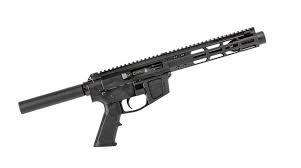Gadget
The Essentials of Modern Firearm Uppers: Functionality and Compatibility

Key Features of High-Performance Firearm Uppers
Within the community of firearm enthusiasts, several vital characteristics emerge when the conversation turns to the functionality of high-performance uppers. The discerning eye looks for durability in the materials: should it be the rugged resilience of 7075-T6 aluminum or the robustness of cold-hammer-forged stainless steel? Furthermore, the manufacturing process itself is pivotal. Precision machining can spell the difference between mediocrity and excellence, granting the upper receiver a level of structural exactitude that ensures each shot is as accurate as the preceding one. Advanced design features, such as reduced-weight fluting, preserve essential robustness and enhance the firearm’s handling. Ultimately, the goal is performance under pressure, achieved through features such as long-lasting protective finishes, including nitriding or anodization, which guard against environmental stressors and the rigors of regular use.
Understanding the Role of a Firearm Upper
The upper receiver of a firearm might be perceived as just one constituent among many, but its role is undeniably central to a firearm’s operation. Think of it as the backbone; it’s where the linear alignment of the barrel converges with the intricate workings of the bolt carrier group and the precision of the charging handle. The steadiness and accuracy of a firearm largely hinge upon the quality of the upper receiver. A meticulously engineered piece, such as a state-of-the-art FM-9 upper, is a testament to this. It underscores the crucial relationship between the upper and the shooter’s ability to consistently hit the mark, whether on the range or in a tactical situation.
Compatibility Considerations for Custom Builds
Personalizing a firearm is akin to conducting an orchestra; each piece must perfectly harmonize. For the builder, this means selecting an upper receiver that seamlessly integrates with an array of components – from the precise pull of a trigger assembly to the nuanced operation of the buffer system. Modularity reigns supreme in the current landscape of firearms, with shooters preferring platforms that allow them to interchange parts and customize their setup to their specific preferences. This flexibility amplifies the importance of ensuring each firearm element, beginning with the upper, is compatible, reliable, and up to spec.
The Advantages of Side-Charging Uppers
Among the innovations propelling firearm technology forward, the emergence of side-charging uppers has carved out its niche for those seeking an operational efficiency edge. This departure from the conventional rear-charging design is more than merely aesthetic; it is a practical evolution. The ability to chamber a round without relinquishing a firm grip or disrupting the alignment of one’s aim is an invaluable feature in tactical scenarios where speed and response time are critical. A side-charging upper allows for the swift cycling of the action, making it easier for the shooter to stay on target and ready for a follow-up shot with minimal motion and effort.
Maintenance and Care for Long-Term Reliability
Ownership of a high-performance upper receiver carries the responsibility of ongoing maintenance. Neglect here can lead to diminished accuracy or, worse, mechanical failure. Each session at the range should ideally conclude with a thorough cleaning of the upper, especially the barrel and bolt carrier group, to prevent the accumulation of residues that can corrode the parts. An inspection for signs of abnormal wear or damage is equally vital. This diligence extends to maintaining optimal storage environments that don’t swing to extremes of humidity or dryness, as such conditions can compromise metal and polymer components over time. By cultivating these routine care practices, one ensures that the upper receiver and the entire firearm remain as reliable as they were.
Legal Aspects and Safety Protocols in Firearm Customization
The tapestry of modern firearm ownership is woven with many legal threads that govern customization and use. It is paramount for enthusiasts to ensure they operate within the law’s ambit, which often varies significantly across jurisdictions. This legal awareness is as crucial as adhering to strict safety protocols, including handling the firearm carefully during modification processes, unloading it when not in use, and selecting the appropriate tools for the job. Such rigorous attention to legal compliance and safe handling is essential in protecting the user and the broader community.
Future Trends and Technological Advancements
The realm of firearm uppers is one marked by relentless innovation. As materials science advances, so does the potential for lighter, more robust uppers made from cutting-edge composites or through techniques like additive manufacturing. The prediction is that these advances will dovetail with user needs, ushering in a generation of firearm uppers that are more customizable, more user-friendly, and distinctly ahead of their time. Keeping abreast of these future trends is crucial for those at the forefront of firearm use and design.
Keeping tabs on the pulse of the industry and staying informed about the latest developments is part and parcel of being a responsible gun enthusiast. To deepen your understanding of the ongoing advancements in firearm technology, articles from authoritative sources such as The New Tech and Gear at SHOT Show can offer valuable insights and coverage of the contemporary innovations reshaping the firearm industry.
Also Read: Decoding the Secrets of the Cat in the Chrysalis Spoiler

-

 Education7 months ago
Education7 months agoExploring Dayforce: Revolutionizing the Trader Joe’s Employee Experience
-

 Education7 months ago
Education7 months agoSDC Website sign in: Your Gateway to Success
-

 Health7 months ago
Health7 months ago10desires.org Health: Your Guide to a Better Well-being
-

 Education7 months ago
Education7 months agoUnlocking the Power of Education: 73147 Education
-

 FOOD7 months ago
FOOD7 months agoCrybaby Noodles: A Delightful Culinary Adventure
-

 FASHION7 months ago
FASHION7 months agoEmbracing Elegance: The Allure of Oval Engagement Ring
-

 Education7 months ago
Education7 months agoNavigating the Labyrinths of Learning: The Importance of school hallways
-

 Education7 months ago
Education7 months ago“Oh Em Gee Blog”: Your Ultimate Guide to a Trendy Online World